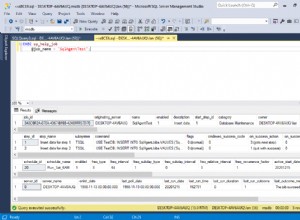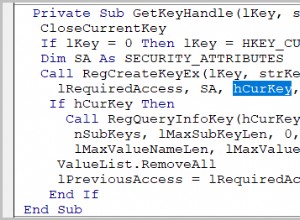Introducción
A menudo, existe la necesidad de controlar el crecimiento de todas las tablas y archivos de todas las bases de datos.
En este artículo, vamos a explorar un ejemplo de cómo automatizar la recopilación de datos sobre el crecimiento de las tablas y archivos de la base de datos de SQL Server.
Solución
- Cree una vista sobre el tamaño de todas las tablas para cada base de datos
USE [DATABASE_NAME] GO SET ANSI_NULLS ON GO SET QUOTED_IDENTIFIER ON GO CREATE view [inf].[vTableSize] as with pagesizeKB as ( SELECT low / 1024 as PageSizeKB FROM master.dbo.spt_values WHERE number = 1 AND type = 'E' ) ,f_size as ( select p.[object_id], sum([total_pages]) as TotalPageSize, sum([used_pages]) as UsedPageSize, sum([data_pages]) as DataPageSize from sys.partitions p join sys.allocation_units a on p.partition_id = a.container_id left join sys.internal_tables it on p.object_id = it.object_id WHERE OBJECTPROPERTY(p.[object_id], N'IsUserTable') = 1 group by p.[object_id] ) ,tbl as ( SELECT t.[schema_id], t.[object_id], i1.rowcnt as CountRows, (COALESCE(SUM(i1.reserved), 0) + COALESCE(SUM(i2.reserved), 0)) * (select top(1) PageSizeKB from pagesizeKB) as ReservedKB, (COALESCE(SUM(i1.dpages), 0) + COALESCE(SUM(i2.used), 0)) * (select top(1) PageSizeKB from pagesizeKB) as DataKB, ((COALESCE(SUM(i1.used), 0) + COALESCE(SUM(i2.used), 0)) - (COALESCE(SUM(i1.dpages), 0) + COALESCE(SUM(i2.used), 0))) * (select top(1) PageSizeKB from pagesizeKB) as IndexSizeKB, ((COALESCE(SUM(i1.reserved), 0) + COALESCE(SUM(i2.reserved), 0)) - (COALESCE(SUM(i1.used), 0) + COALESCE(SUM(i2.used), 0))) * (select top(1) PageSizeKB from pagesizeKB) as UnusedKB FROM sys.tables as t LEFT OUTER JOIN sysindexes as i1 ON i1.id = t.[object_id] AND i1.indid < 2 LEFT OUTER JOIN sysindexes as i2 ON i2.id = t.[object_id] AND i2.indid = 255 WHERE OBJECTPROPERTY(t.[object_id], N'IsUserTable') = 1 OR (OBJECTPROPERTY(t.[object_id], N'IsView') = 1 AND OBJECTPROPERTY(t.[object_id], N'IsIndexed') = 1) GROUP BY t.[schema_id], t.[object_id], i1.rowcnt ) SELECT @@Servername AS Server, DB_NAME() AS DBName, SCHEMA_NAME(t.[schema_id]) as SchemaName, OBJECT_NAME(t.[object_id]) as TableName, t.CountRows, t.ReservedKB, t.DataKB, t.IndexSizeKB, t.UnusedKB, f.TotalPageSize*(select top(1) PageSizeKB from pagesizeKB) as TotalPageSizeKB, f.UsedPageSize*(select top(1) PageSizeKB from pagesizeKB) as UsedPageSizeKB, f.DataPageSize*(select top(1) PageSizeKB from pagesizeKB) as DataPageSizeKB FROM f_size as f inner join tbl as t on t.[object_id]=f.[object_id] GO
- Cree una base de datos específica y determine una tabla para almacenar información sobre el crecimiento de todas las tablas de la base de datos:
USE [DATABASE_NAME] GO SET ANSI_NULLS ON GO SET QUOTED_IDENTIFIER ON GO SET ANSI_PADDING ON GO CREATE TABLE [srv].[TableStatistics]( [Row_GUID] [uniqueidentifier] NOT NULL CONSTRAINT [DF_TableStatistics_Row_GUID] DEFAULT (newid()), [ServerName] [nvarchar](255) NOT NULL, [DBName] [nvarchar](255) NOT NULL, [SchemaName] [nvarchar](255) NOT NULL, [TableName] [nvarchar](255) NOT NULL, [CountRows] [bigint] NOT NULL, [DataKB] [int] NOT NULL, [IndexSizeKB] [int] NOT NULL, [UnusedKB] [int] NOT NULL, [ReservedKB] [int] NOT NULL, [InsertUTCDate] [datetime] NOT NULL CONSTRAINT [DF_TableStatistics_InsertUTCDate] DEFAULT (getutcdate()), [Date] AS (CONVERT([date],[InsertUTCDate])) PERSISTED, [CountRowsBack] [bigint] NULL, [CountRowsNext] [bigint] NULL, [DataKBBack] [int] NULL, [DataKBNext] [int] NULL, [IndexSizeKBBack] [int] NULL, [IndexSizeKBNext] [int] NULL, [UnusedKBBack] [int] NULL, [UnusedKBNext] [int] NULL, [ReservedKBBack] [int] NULL, [ReservedKBNext] [int] NULL, [AvgCountRows] AS ((([CountRowsBack]+[CountRows])+[CountRowsNext])/(3)) PERSISTED, [AvgDataKB] AS ((([DataKBBack]+[DataKB])+[DataKBNext])/(3)) PERSISTED, [AvgIndexSizeKB] AS ((([IndexSizeKBBack]+[IndexSizeKB])+[IndexSizeKBNext])/(3)) PERSISTED, [AvgUnusedKB] AS ((([UnusedKBBack]+[UnusedKB])+[UnusedKBNext])/(3)) PERSISTED, [AvgReservedKB] AS ((([ReservedKBBack]+[ReservedKB])+[ReservedKBNext])/(3)) PERSISTED, [DiffCountRows] AS (([CountRowsNext]+[CountRowsBack])-(2)*[CountRows]) PERSISTED, [DiffDataKB] AS (([DataKBNext]+[DataKBBack])-(2)*[DataKB]) PERSISTED, [DiffIndexSizeKB] AS (([IndexSizeKBNext]+[IndexSizeKBBack])-(2)*[IndexSizeKB]) PERSISTED, [DiffUnusedKB] AS (([UnusedKBNext]+[UnusedKBBack])-(2)*[UnusedKB]) PERSISTED, [DiffReservedKB] AS (([ReservedKBNext]+[ReservedKBBack])-(2)*[ReservedKB]) PERSISTED, [TotalPageSizeKB] [int] NULL, [TotalPageSizeKBBack] [int] NULL, [TotalPageSizeKBNext] [int] NULL, [UsedPageSizeKB] [int] NULL, [UsedPageSizeKBBack] [int] NULL, [UsedPageSizeKBNext] [int] NULL, [DataPageSizeKB] [int] NULL, [DataPageSizeKBBack] [int] NULL, [DataPageSizeKBNext] [int] NULL, [AvgDataPageSizeKB] AS ((([DataPageSizeKBBack]+[DataPageSizeKB])+[DataPageSizeKBNext])/(3)) PERSISTED, [AvgUsedPageSizeKB] AS ((([UsedPageSizeKBBack]+[UsedPageSizeKB])+[UsedPageSizeKBNext])/(3)) PERSISTED, [AvgTotalPageSizeKB] AS ((([TotalPageSizeKBBack]+[TotalPageSizeKB])+[TotalPageSizeKBNext])/(3)) PERSISTED, [DiffDataPageSizeKB] AS (([DataPageSizeKBNext]+[DataPageSizeKBBack])-(2)*[DataPageSizeKB]) PERSISTED,--shows as the casting is changed [DiffUsedPageSizeKB] AS (([UsedPageSizeKBNext]+[UsedPageSizeKBBack])-(2)*[UsedPageSizeKB]) PERSISTED,--shows as the casting is changed [DiffTotalPageSizeKB] AS (([TotalPageSizeKBNext]+[TotalPageSizeKBBack])-(2)*[TotalPageSizeKB]) PERSISTED,--shows as the casting is changed CONSTRAINT [PK_TableStatistics] PRIMARY KEY CLUSTERED ( [Row_GUID] ASC )WITH (PAD_INDEX = OFF, STATISTICS_NORECOMPUTE = OFF, IGNORE_DUP_KEY = OFF, ALLOW_ROW_LOCKS = ON, ALLOW_PAGE_LOCKS = ON) ON [PRIMARY] ) ON [PRIMARY] GO SET ANSI_PADDING ON GO
TotalPageSizeKB indica el tamaño de la tabla.
El total de TotalPageSizeKB de todas las tablas de la base de datos + el tamaño de las tablas del sistema =el tamaño de los datos de la base de datos.
- Determine el procedimiento para recopilar la información:
USE [DATABASE_NAME] GO SET ANSI_NULLS ON GO SET QUOTED_IDENTIFIER ON GO CREATE PROCEDURE [srv].[InsertTableStatistics] AS BEGIN SET NOCOUNT ON; SET TRANSACTION ISOLATION LEVEL READ UNCOMMITTED; declare @dt date=CAST(GetUTCDate() as date); declare @dbs nvarchar(255); declare @sql nvarchar(max); select [name] into #dbs from sys.databases; while(exists(select top(1) 1 from #dbs)) begin select top(1) @dbs=[name] from #dbs; set @sql= N'INSERT INTO [srv].[TableStatistics] ([ServerName] ,[DBName] ,[SchemaName] ,[TableName] ,[CountRows] ,[DataKB] ,[IndexSizeKB] ,[UnusedKB] ,[ReservedKB] ,[TotalPageSizeKB] ,[UsedPageSizeKB] ,[DataPageSizeKB]) SELECT [Server] ,[DBName] ,[SchemaName] ,[TableName] ,[CountRows] ,[DataKB] ,[IndexSizeKB] ,[UnusedKB] ,[ReservedKB] ,[TotalPageSizeKB] ,[UsedPageSizeKB] ,[DataPageSizeKB] FROM ['[email protected]+'].[inf].[vTableSize];'; exec sp_executesql @sql; delete from #dbs where [name][email protected]; end drop table #dbs; declare @dt_back date=CAST(DateAdd(day,-1,@dt) as date); ;with tbl1 as ( select [Date], [CountRows], [DataKB], [IndexSizeKB], [UnusedKB], [ReservedKB], [ServerName], [DBName], [SchemaName], [TableName], [TotalPageSizeKB], [UsedPageSizeKB], [DataPageSizeKB] from [srv].[TableStatistics] where [Date][email protected]_back ) , tbl2 as ( select [Date], [CountRows], [CountRowsBack], [DataKBBack], [IndexSizeKBBack], [UnusedKBBack], [ReservedKBBack], [ServerName], [DBName], [SchemaName], [TableName], [TotalPageSizeKBBack], [UsedPageSizeKBBack], [DataPageSizeKBBack] from [srv].[TableStatistics] where [Date][email protected] ) update t2 set t2.[CountRowsBack] =t1.[CountRows], t2.[DataKBBack] =t1.[DataKB], t2.[IndexSizeKBBack] =t1.[IndexSizeKB], t2.[UnusedKBBack] =t1.[UnusedKB], t2.[ReservedKBBack] =t1.[ReservedKB], t2.[TotalPageSizeKBBack]=t1.[TotalPageSizeKB], t2.[UsedPageSizeKBBack] =t1.[UsedPageSizeKB], t2.[DataPageSizeKBBack] =t1.[DataPageSizeKB] from tbl1 as t1 inner join tbl2 as t2 on t1.[Date]=DateAdd(day,-1,t2.[Date]) and t1.[ServerName]=t2.[ServerName] and t1.[DBName]=t2.[DBName] and t1.[SchemaName]=t2.[SchemaName] and t1.[TableName]=t2.[TableName]; ;with tbl1 as ( select [Date], [CountRows], [CountRowsNext], [DataKBNext], [IndexSizeKBNext], [UnusedKBNext], [ReservedKBNext], [ServerName], [DBName], [SchemaName], [TableName], [TotalPageSizeKBNext], [UsedPageSizeKBNext], [DataPageSizeKBNext] from [srv].[TableStatistics] where [Date][email protected]_back ) , tbl2 as ( select [Date], [CountRows], [DataKB], [IndexSizeKB], [UnusedKB], [ReservedKB], [ServerName], [DBName], [SchemaName], [TableName], [TotalPageSizeKB], [UsedPageSizeKB], [DataPageSizeKB] from [srv].[TableStatistics] where [Date][email protected] ) update t1 set t1.[CountRowsNext] =t2.[CountRows], t1.[DataKBNext] =t2.[DataKB], t1.[IndexSizeKBNext] =t2.[IndexSizeKB], t1.[UnusedKBNext] =t2.[UnusedKB], t1.[ReservedKBNext] =t2.[ReservedKB], t1.[TotalPageSizeKBNext]=t2.[TotalPageSizeKB], t1.[UsedPageSizeKBNext] =t2.[UsedPageSizeKB], t1.[DataPageSizeKBNext] =t2.[DataPageSizeKB] from tbl1 as t1 inner join tbl2 as t2 on t1.[Date]=DateAdd(day,-1,t2.[Date]) and t1.[ServerName]=t2.[ServerName] and t1.[DBName]=t2.[DBName] and t1.[SchemaName]=t2.[SchemaName] and t1.[TableName]=t2.[TableName]; END GOEsta solución se puede modificar para recopilar datos sobre los tamaños de las tablas de todas las bases de datos de todas las instancias requeridas de MS SQL Server.
- Defina la vista según la información recopilada:
USE [DATABASE_NAME] GO SET ANSI_NULLS ON GO SET QUOTED_IDENTIFIER ON GO create view [srv].[vTableStatisticsShort] as with d as (select DateAdd(day,-1,max([Date])) as [Date] from [srv].[TableStatistics]) SELECT t.[ServerName] ,t.[DBName] ,t.[SchemaName] ,t.[TableName] ,t.[CountRows] ,t.[DataKB] ,t.[IndexSizeKB] ,t.[UnusedKB] ,t.[ReservedKB] ,t.[InsertUTCDate] ,t.[Date] ,t.[CountRowsBack] ,t.[CountRowsNext] ,t.[DataKBBack] ,t.[DataKBNext] ,t.[IndexSizeKBBack] ,t.[IndexSizeKBNext] ,t.[UnusedKBBack] ,t.[UnusedKBNext] ,t.[ReservedKBBack] ,t.[ReservedKBNext] ,t.[AvgCountRows] ,t.[AvgDataKB] ,t.[AvgIndexSizeKB] ,t.[AvgUnusedKB] ,t.[AvgReservedKB] ,t.[DiffCountRows] ,t.[DiffDataKB] ,t.[DiffIndexSizeKB] ,t.[DiffUnusedKB] ,t.[DiffReservedKB] ,t.[TotalPageSizeKB] ,t.[TotalPageSizeKBBack] ,t.[TotalPageSizeKBNext] ,t.[UsedPageSizeKB] ,t.[UsedPageSizeKBBack] ,t.[UsedPageSizeKBNext] ,t.[DataPageSizeKB] ,t.[DataPageSizeKBBack] ,t.[DataPageSizeKBNext] ,t.[AvgDataPageSizeKB] ,t.[AvgUsedPageSizeKB] ,t.[AvgTotalPageSizeKB] ,t.[DiffDataPageSizeKB] ,t.[DiffUsedPageSizeKB] ,t.[DiffTotalPageSizeKB] FROM d inner join [SRV].[srv].[TableStatistics] as t on d.[Date]=t.[Date] where t.[CountRowsBack] is not null and t.[CountRowsNext] is not null GOAquí me gustaría llamar su atención sobre Diff. Si es superior a 0, significa que la tabla crece cada día más rápido.
Se supone que la recolección debe realizarse una vez cada 24 horas.
De la misma manera, podemos automatizar la recopilación del archivo de crecimiento de todas las bases de datos utilizando la siguiente vista:
USE [DATABASE_NAME] GO SET ANSI_NULLS ON GO SET QUOTED_IDENTIFIER ON GO select t2.[DB_Name] as [DBName] ,t1.FileId ,t1.NumberReads ,t1.BytesRead ,t1.IoStallReadMS ,t1.NumberWrites ,t1.BytesWritten ,t1.IoStallWriteMS ,t1.IoStallMS ,t1.BytesOnDisk ,t1.[TimeStamp] ,t1.FileHandle ,t2.[Type_desc] ,t2.[FileName] ,t2.[Drive] ,t2.[Physical_Name] ,t2.[Ext] ,t2.[CountPage] ,t2.[SizeMb] ,t2.[SizeGb] ,t2.[Growth] ,t2.[GrowthMb] ,t2.[GrowthGb] ,t2.[GrowthPercent] ,t2.[is_percent_growth] ,t2.[database_id] ,t2.[State] ,t2.[StateDesc] ,t2.[IsMediaReadOnly] ,t2.[IsReadOnly] ,t2.[IsSpace] ,t2.[IsNameReserved] ,t2.[CreateLsn] ,t2.[DropLsn] ,t2.[ReadOnlyLsn] ,t2.[ReadWriteLsn] ,t2.[DifferentialBaseLsn] ,t2.[DifferentialBaseGuid] ,t2.[DifferentialBaseTime] ,t2.[RedoStartLsn] ,t2.[RedoStartForkGuid] ,t2.[RedoTargetLsn] ,t2.[RedoTargetForkGuid] ,t2.[BackupLsn] from fn_virtualfilestats(NULL, NULL) as t1 inner join [inf].[ServerDBFileInfo] as t2 on t1.[DbId]=t2.[database_id] and t1.[FileId]=t2.[File_Id] GO
Resultado
En este artículo, exploramos el ejemplo de la automatización de la recopilación de datos sobre el tamaño y el crecimiento de todas las tablas y archivos de SQL Server de todas las bases de datos. Nos proporciona el control completo sobre el cambio de tamaño tanto de los archivos de la base de datos como de sus tablas, así como la toma de medidas oportunas para reducir la tabla o el archivo, aumentar el dispositivo de almacenamiento de datos o dividir la información en múltiples dispositivos de almacenamiento de datos.




